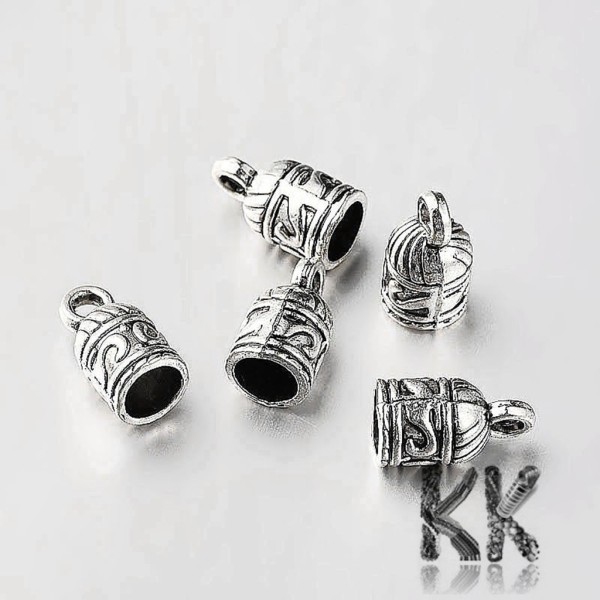Zinc Alloy Cord End Caps - 13 x 7 mm - Inner diameter 5 mm, Hole: 2 mm
Tibetan-style zinc alloy cord end cap suitable for ending bracelets or necklaces with an inner diameter of up to 5 mm. The end cap measures 7 x 13 mm and the eyelet has a diameter of 2 mm.
THE PRICE IS FOR 1 PCS.
Tibetan-style zinc alloy cord end cap suitable for ending bracelets or necklaces with an inner diameter of up to 5 mm. The end cap measures 7 x 13 mm and the eyelet has a diameter of 2 mm.
This is an alloy with no exact proportions of the different metals and each manufacturer adjusts it to suit their needs. The largest proportion in the alloy contains zinc and then usually copper, but some manufacturers substitute iron or nickel. In small and trace amounts (0.01-1%), the alloy may contain a truly varied mixture of impurities (including non-metallic elements such as phosphorus, silicon, carbon and others) - some of which serve to cheapen the alloy, others to improve its properties.
Due to the colour settings on the monitor, the colour of the item may vary slightly from reality.ality.
Data sheet
- Weight
- cca 0,7 g
- Shape
- Bell
- Information on allergens and heavy metals
- RoHS certificate
.
How to identify dyed minerals, artificial minerals and imitations? Simple hammer test can do the trick..
-
How to choose correctly?
-
What is the difference between waxing, dyeing, heating?
-
Why do beads fade?
-
Is there anything I can do against it?
-
Hammer tests for Jade, Agate, Malachite, Opalite, Azurite, Turquoise, Tyrkenite, Larimar, Hematite and Coral
-
When buying beads, why are there different color qualities from the same mineral on the same string?
.
A series of videos to help you navigate your bead selection. Watch the hammer tests where we show the differences in real minerals, synthetic substitutes and plastic imitation minerals. Fortunately, we have everything clearly marked on the Katlas Beads store, we never lie. This is a certainty which is hard to find on other e-shops.
From time to time, we come across someone complaining that they ordered a mineral in a certain colour and that some minerals have a slightly different shade or spots., how do we navigate the selection process? You need to understand that raw minerals are never identical. And it's proof that it's not an imitation or synthetic. On the Katlas beads eshop, you will come across multiple grades of qualities that address these queries.
After watching the videos, you will have accurate information and be able to navigate all the e-stores selling mineral beads.
Don't forget to subscribe to our YouTube channel. You won't miss any important videos and expert advice that will make you an expert in beading.
.
Metals in beads and jewellery components
Take the time to learn everything you need to know in this nine-part video series.
Metals in beads - allergies and differentiation of jewellery metals.
Health hazards in jewellery metals.
Beads and jewellery components made of iron.
Zinc alloy beads and jewellery components.
Beads and jewellery components made of so-called Tibetan silver.
Beads and jewellery components made of brass.
Beads and jewellery components made of aluminium.
Stainless steel beads and jewellery components.
Silver beads and jewellery components.
.
.
Don't forget to subscribe to our YouTube channel. You won't miss any important videos and expert advice that will make you an expert in beading:
.
.
















